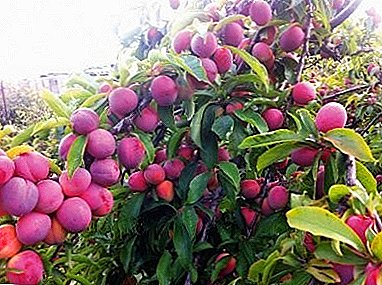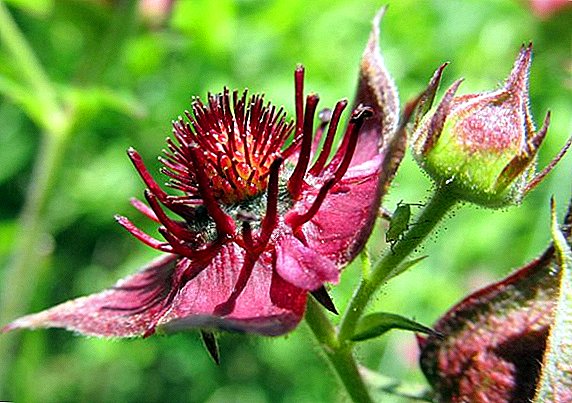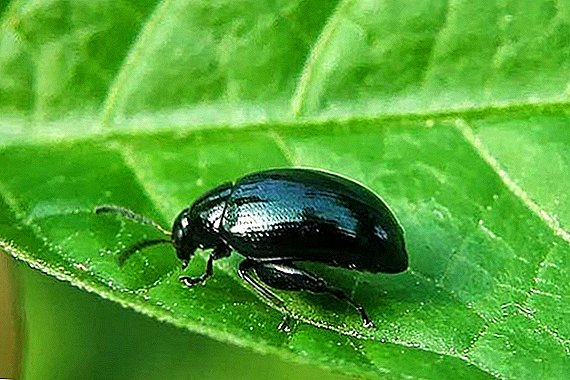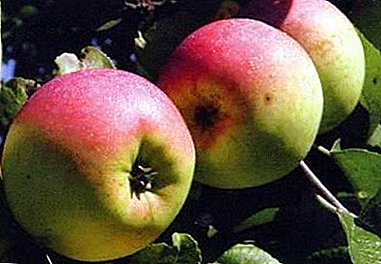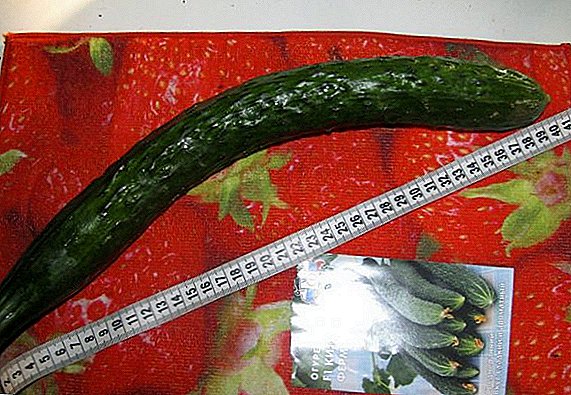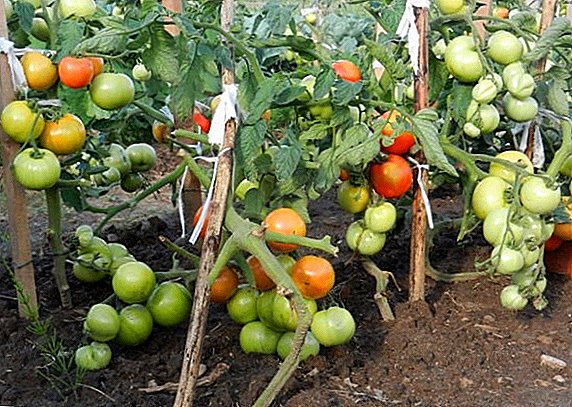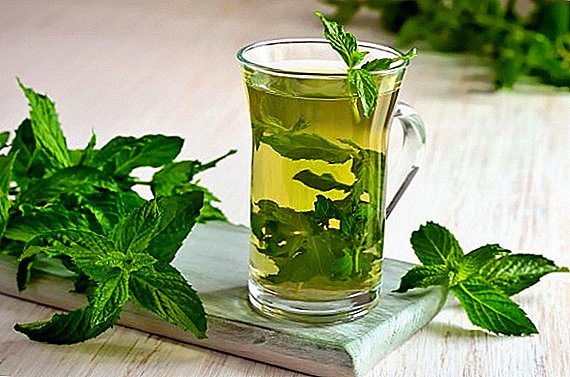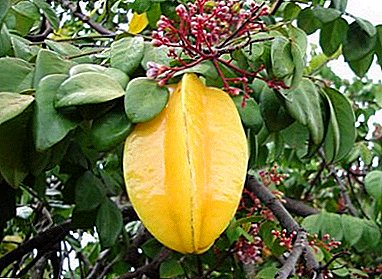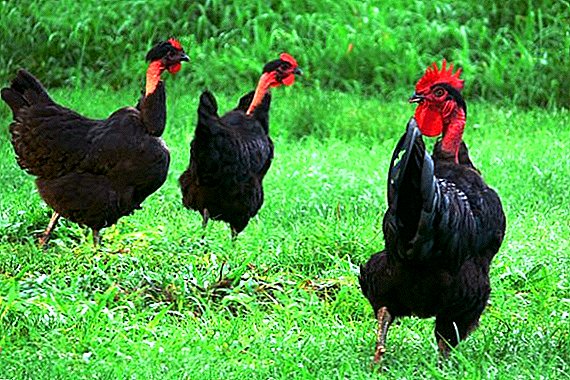 We invite you to familiarize yourself with one of the most unusual breeds of domestic chickens, suitable for any climatic conditions. It will be about the Transylvanian skullcap. This is a chicken with a bare red neck, resulting from a mutation. The bird has a shocking appearance and, at the same time, a quiet disposition. Poultry meat has excellent taste and is considered one of the most dietary.
We invite you to familiarize yourself with one of the most unusual breeds of domestic chickens, suitable for any climatic conditions. It will be about the Transylvanian skullcap. This is a chicken with a bare red neck, resulting from a mutation. The bird has a shocking appearance and, at the same time, a quiet disposition. Poultry meat has excellent taste and is considered one of the most dietary.
Origin
It is not known for certain exactly where this breed comes from, but there is an assumption that Transylvania (Romania) is its birthplace. Hence the name - Transylvanian chicken. There is also a version that the bird comes from Hungary. 
In Romania and Hungary, these chickens are often referred to as Semi Grad goloshes. Spain also fights for the copyright to the breed (the birds could have been bred in the province of Andalusia), in connection with which some poultry farmers call the representatives of the breed the Spanish heads.
Important! Not to be confused Transylvanian golosehek with the French. The French version is not related to Transylvanian. Unlike the French breed, the Transylvanian Habs look more like a turkey in an angry mood.
In addition to Romania, Hungary and Spain, the bird is popular in Moldova, France, Germany, Austria, often found in other European countries. At the same time, Transversian hen's chicken is a very rare guest in the UK and the USA.

External characteristics
The breed standard has the following exterior features:
- The main distinguishing feature - lack of plumage in the neck. The exposure comes from the very base of the neck. Thanks to this highlight, the bird got its nickname - naked. The skin color of a bare neck is bright red.
- Torso cylindrical, medium size, slightly elongated, elevated.
- The chest is powerful, rounded, with developed muscles.
- Stomach volume.
- Back elongated.
- Tail lush, upturned.
- Wings loosely adheres to the body and appears to be slightly lowered.
- Neck has an average length.
- Head of medium size, in front and on the nape is covered with short plumage. A red leaf-shaped scallop with deep teeth is planted on top. Crest well developed.
- Earrings thin, round, red color.
- Eyes intense red (depending on the color of the bird, the tone may be darker or lighter).
- Beak solid size, slightly bent. Depending on the color of the bird, the color of the beak may be different. The colors of the paws are similar to the colors of the beak.
- Legs strong, medium length.
- Weight An adult rooster is about 3 kg, and hens - up to 2.5 kg.
- Coat Transylvanian chickens are not thick. The number of feathers is on average 2 times less than that of other breeds.
- Color plumage in this breed has no standard. The bird is distinguished by a wide variety of shades - black, white, red, fawn and cuckoo. Cutie-colored pigs look especially exotic.

Important! A sign of pedigree is a yellow shade of skin under plumage, as well as yellowness of bare skin. In addition, white catkins, a completely black face, dark eyes, and a graceful body uncharacteristic of this breed indicate the impurity of the bird. Marriage is also indicated by the presence of green reflux on a black fur coat, purple feathers on the whole body of the neck.
Character
The following character traits are characteristic of heels from Transylvania:
- patience and appeasability - if they do not receive food in time, they will not make noise and commotion in the house;
- quite calm, gentle and friendly disposition - successfully cohabit with other breeds in the same house (not hostile);
- love to walk - if you give them this opportunity, birds will thank you with a large number of eggs.
Familiarize yourself with the characteristics and basics of breeding chickens with a bare neck.
Productivity
The productivity of this breed is rather average than high, but golosheyki are considered as good laying hens. Eggs are quite large. 
Transylvanian chicken is characterized by early puberty. Layers begin to give eggs at the age of 6 months.
A bare-necked chicken is a mixed type of productivity (meat and egg breed), that is, chickens are equally well suited for egg production as well as for breeding meat.
The meat and egg breeds of chickens include such ones as master gray, galan, Bress gal, Kyrgyz gray, paduans, velzumer, Moscow white.
The meat is tender and juicy, in taste it resembles turkey meat or guinea fowl.
More detailed information on the productivity of the breed is presented in the table below.
| Productive characteristics of Transylvanian chickens | |
| Mass of chickens | 2.0-2.5 kg (females) |
| 3.0-3.5 kg (males) | |
| Begin egg laying | 23-25th week of life (5.5-6 months of age) |
| Laying Rhythm | 1 time in 2-3 days |
| Egg production for the year | up to 160 pieces (in the first year the number of eggs is 180 pieces, then - 150-160) |
| Egg weight | 58-60 g |
| Egg shell color | cream or beige |

What to feed
Problems with feeding Transylvanian birds you should not have. These crested are unpretentious to the composition of the feed and will gladly consume any food that is offered to them.
Nevertheless, there are some rules, the observance of which will help chickens to stay healthy, as well as increase their productivity.
Find out what should be the diet of chickens.
Wet mash
Cook feathered mash of various products. Transylvanian menu should include root vegetables (beets, carrots), cereals, grass, animal proteins (meat or fish broth, thick soured milk), fodder chalk or shells.
It is useful to add special organic complexes to the combined feed. To increase egg production, premixes (an enrichment mixture of biologically active substances) are added to the diet of goose quills. Also use mineral supplements - alternate shredded shells and bone meal. 
Greenery
In the summer season, when walking, livestock can peck greens, thereby enriching your body with organic matter. In winter, the same chickens are deprived. In regions with a cold climate, they need energy feed.
Important! Feeding up feathered beauties is impossible. A fat female will stop laying eggs.
It is desirable to increase the amount of grain and animal feed in the menu of birds. Professional poultry farmers recommend adding clover and pine flour to the feed mixtures. An excellent option is a balanced mash, rich in all the necessary elements.
In winter, you can even slightly increase the rate of such feed. 
Yeast
Yeast should be given to chickens separately. This is due to the fact that as soon as you add the yeast to the mash, the mixture will deteriorate very quickly.
Dry grain
In this case, you can buy ready-made combined feed.
Find out what types of feed for chickens are, and how to prepare the most feed for poultry.
If you yourself are engaged in the harvesting of cereals, then take care of the diversity of the Transylvanian canine menu. Approximately 55% of the daily feed requirement should be dry grain - wheat, corn, rye, barley and other cereals.
Conditions of detention
Despite the presence of skin areas devoid of feathers, the bird is perfectly adapted to the harsh winters. Egg production remains in December-January, even though there will be no heating in the house. However, make sure that in the house of feathered temperature indicators do not fall below zero. The ideal temperature is 12-15 ° C. 
Here are some more important tips for maintaining and caring for the breed:
- Arrange for good living conditions. They need a spacious home with low perches. To avoid disassembly, arrange the perches so that the hens feel free.
- The guarantee of bird health is a dry floor in the house. Peat can be considered the best material for litter - it does not just perfectly absorb moisture, but also serves as an obstacle to the reproduction of microbes and parasites.
- Another very important condition for the content of the necks is the presence in the hen house ventilation system. Air exchange serves as prevention of reproduction of pathogenic microorganisms.
In all other nuances follow the standard rules for homemade chicken. 
Nursing care
The offspring of barefoot has good health and is growing rapidly. Hatched babies have a high degree of endurance - almost 95% of the young survive. They are unpretentious, easily tolerate transportation.
Did you know? In 1956, a hen, nicknamed Blanche, laid an egg with 2 yolks and a double shell. Weighed this unique copy of 454 g.
Consider a few important rules regarding chick care:
- Feeding babies standard. From the first days of life, give the chickens hard-boiled eggs, chiseling with semolina. Also, crumbs laid greens and water.
- After 3 days, you can enter into the diet of new products. Pets-babies can be grown on special mash bags for chicks, or they can feed them themselves. In the latter case, animal proteins and fish oil should certainly be included in the menu. These products serve to prevent the development of rickets. In the wet mixture, add grated beets, carrots, chopped vegetable tops or grass.
- Chickens grow at a rapid pace, so their daily menu must be enriched with protein components, as well as organic matter and minerals. For example, for the proper formation of the skeleton, the crumbs need calcium, and for the development of muscle mass they need protein. A rich source of protein and calcium are fermented milk products (cottage cheese, thick soured milk).
- Young animals grow healthy and strong if more often in the sun and fresh air.
- Hygienic requirements for the content of babashees-babies - traditional.

Advantages and disadvantages
Summing up, we give a list of the advantages and disadvantages of the breed.
Did you know? There are a lot of domestic chickens on Earth. Their number exceeds the number of people in the ratio of 3: 1.
Among the many advantages golosehek should highlight such:
- general endurance, unpretentiousness (not picky in nutrition and maintenance) and frost resistance (adapted to sub-zero temperatures);
- high survival rate of young stock (94%);
- Chicks easily tolerate transportation;
- calm nature, lack of hostility to representatives of other breeds;
- ease of care;
- early onset laying;
- mixed type of productivity (diluted for meat and eggs);
- convenience in processing the carcass (due to bare areas of the body, the process of plucking is significantly simplified);
- excellent taste of meat (like dietary turkey meat);
- attractive appearance of eggs (large, with a strong shell).

The disadvantages include:
- short period of productivity;
- poorly formed maternal feelings (problems with the incubation instinct).
By minus golosehek conditionally can be attributed unattractive appearance of the bird. In addition, due to the small number of feathers on the body, the birds have an unhealthy appearance and seem molting. Because of these exterior features, there are not many who want to have this breed in their house.
Did you know? There are a lot of people suffering from panic fear of chickens and chickens. This phobia has a formal name - alektorophobia (alektorophobia). Surprisingly, these people are also afraid of everything that they can be reminded of these birds (for example, feathers and even eggs). Panic fear is not innate - it is triggered by a specific incident that struck the mind of a person. This may be a minor event of a distant past, which a person has already forgotten. And it is likely that this event was not related to the living bird. Such an impact on the nervous system could occur, for example, in childhood after watching a cartoon or film, and yet the subconscious phobia continues to own the human mind.
Egg production in poultry is average, so the productivity of the breed cannot be considered either as a virtue or a disadvantage.

So, we have seen that a naked hen is almost an ideal breed for breeding. But, unfortunately, it can not get wide distribution. And the only reason for this is the unsightly appearance.
However, experienced poultry farmers, already in practice, acquainted with all the advantages of this breed, do not bother her external unattractiveness. Connoisseurs appreciate these birds and believe that, over time, Transylvanians will take their deserved place in private farmsteads.


